The Wearing of "SPECIAL" Garments
1. Kipa also known as yarmulke: Is it the "hat of Hermes"?
In the Hebrew language, the word "Kippah" means dome.
As odd as it may seem, the domed beanie-hat seen on popes, cardinals, orthodox rabbis, and some oriental folks is derived from the Greek hat of Hermes, the Greek deity of the mind. Commerce, fortune, gymnastics, cunning, wisdom, and shrewdness were celebrated in his honor. Hermes is really big with the Masons. To them he's the "god" of wisdom, also known as Thoth or Set. You've seen adaptations of his hat worn by graduates and their professors, but slightly disguised beneath a square "mortar board", another weird custom inherited from the guilds (sort of union-run schools) of the Middle Ages. Ceremonies and "initiations" are very important to the hood-winkery that they engage in. Take a gander at this happy fellow, gleefully following the Hermetic traditions:
"WISE GUY" ready for the parade:

"DOCTOR" is Latin for "TEACHER"
They taught building techniques and architecture, and were students of "masonry" -- which relates to the "mortar board" hat over the domed beanie. These guys were REAL masons, not members of the Blue Lodge, fiddling with swords and dreaming of being secret knights. When these brutes put on their "aprons of righteousness" with all the little symbols on them, it meant they had paid their union dues -- so they could work "righteously" (in good standing), and not working without being a guild member in good standing. When you research the origin of a little hat called a "FEZ", you'll see it's linked to all this information. 33rd degree Masons (the Adepts / Illuminati) are fond of wearing a big red FEZ with a tassel on it. This is just great fun, isn't it? Now when you watch them put on their "caps and gowns" at the graduation ceremonies, you can snicker under your breath a little, knowing they have NO CLUE why they are wearing such a costume. The following is a brief excerpt from the book, Fossilized Customs:
"Yarmulke" is a Yiddish word for the kipa, or skullcap seen worn by the pope, and most orthodox Yahudim on the street, in the classroom, and in the synagogues. Mosheh would not know what it is. Alfred J. Kolatch, an orthodox author and "rabbi", states: "The skullcap has no religious significance in Jewish law." He goes on to say that it has no basis in Scriptural or Rabbinical law. To trace the use of the cap to its source, we find that it came into wider use only in the 17th century, where before that only a very few Yahudim used it. Did Rabbi Yahushua wear a kipa? All researchers and historians say NO, and there is no evidence of its use in any data or archaeological finds at all. The pope of Rome and his cardinals wear them, but that is because it was originally a Greek hat of a scholar, called the "hat of Hermes" (Hermes is a Pagan idol, of course). You will recall the "cap and gown" of graduates from schools and universities employs this "hat of Hermes", topped with a square mason's board. A mason is a layer of bricks, and the mason's board holds the cement mix. These were scholars who graduated to different levels in their guilds; from apprentice to journeyman, then journeyman to master.
In ancient times, just prior to 186 BCE, the land of Yisrael was ruled by a Greek Seleucid, Antiochus Epiphanes IV. He was extremely cruel, and outlawed the Hebrew religion, forcing his Greek customs on them. In the record of 2 Maccabees, an apostate high priest (named "Jason" in translation, but really named Y'shua) helped this Greek ruler impose the Greek ways of living:
"And abrogating the lawful way of living, he introduced new customs contrary to the Torah; for he willingly established a gymnasium right under the citadel (the Temple), and he made the finest of the young men wear the Greek hat." (Recall that Hermes, the Greek deity of the mind, was associated with skills in commerce, fortune, gymnastics, cunning, and shrewdness. Reading the previous quote carefully, it is obvious that the "gymnasium" and the "finest of the young men" are linked to the special "hat" they were made to wear. This strongly implies that Hermes was involved, and the prowess and skill of the young men was rewarded. The hat must have been an icon or badge of honor to the Greeks for skill in gymnastics, leaving no doubt that Hermes would be the deity related to the hat.)
Paul writes at 1 Cor. 11:7 that a man is not to have his head covered in the assembly, but a woman is required to, to keep from dishonoring one another's headship. Yahushua is the man's ‘head', while a woman's ‘head' is her husband. We are to follow the Torah, and not add to it in any way: "Do not add to nor take away from it". Dt. 12:32, Dt. 12:32.
Man-made customs, including all the camouflaged Paganism found in Christendom, are traditions that are forbidden in the worship of YHWH. They represent more than a "strange fire", but are like the golden calf. It is forbidden to worship Him after the customs of the Pagans. "The one who says he abides in Him ought himself to walk in the same manner as He walked." ~ 1 John 2:6. Walk in Light ~ the Torah. (END OF EXCERPT)
Here's more historical data on the use of the kipa (dome), the Greek hat of Hermes:
The kipa or yarmulke is discussed in several books I've read by Orthodox rabbis, and they agree it is of human invention. And, they admit it has been a tradition for many centuries, but only became "popularized" because many people began to wear them during the 17th and 18th centuries. "Monkey see, monkey do" and false piety (hypocrisy) drives many things of this nature, no doubt.
One book I managed to easily put my hands on tonight is "The Jewish Book Of Why", by Alfred J. Kolatch (possibly some data about him is on the internet). I also have the "Second Jewish Book Of Why" stored somewhere. On page 2 of the former book, our Jewish brother writes:
"Were a Jew of the generation of Moses or Solomon or Judah the Maccabee alive today, (obviously he misuses the term "Jew" here, since Mosheh was of the tribe of Lewi), he would be quite confused as he observed our religious conduct. He would look at the kipa (skullcap) that we wear and ask, 'Why do Jews wear them? What are they for?' He would notice the gartl (girdle) and shtreiml (fur hat) worn by the chassid and be puzzled by the special garb."
He goes on and on, listing many things that Mosheh and the others would not know anything about, nor understand. And Alfred writes from the perspective of an Orthodox Yahudi, explaining things "Jewish" to other "Jews" who wonder about them - there is little doubt we Natsarim would wonder also!
On page 121 of the book, "The Jewish Book Of Why", by Alfred J. Kolatch, he continues more on the subject of the yarmulke: (comments in blue)
"Why are yarmulkes worn?
A yarmulke, called a kipa in Hebrew, is a skullcap worn by Jews. Some wear one at all times, others only during prayer and at mealtime.
The earliest Jewish reference to a headcovering can be found in Exodus 28:4, where it is called a mitznefet. It was part of the wardrobe of the High Priest. In other biblical reference, the covering of the head and face is regarded as a sign of mourning (II Samuel 15:30). The Talmud, however, associates the wearing of a headgear more with the concept of reverence (to God) and respect (for men of stature).
(He's left the reality of Torah, and entered the "reasoning" of man's tradition, adding to the Torah).
The word yarmulke is Yiddish, but of uncertain meaning. One view is that the word is derived from the headcovering called armucella, worn by medieval clergy. (Oops, the Pagan stuff is starting to pop up; but let's see how he shrugs it off and hypnotizes himself and the readers).
A more probable explanation is that the word yarmulke is related to the French arme (akin to the Latin arma), a type of round medieval helmet with a movable visor. (Ah, "more probable" because the "movable visor" similarity on traditional Jewish yarmulkes makes an obvious connection!).
Another Yiddish word for yarmulke is koppel (kappel), a form of the Latin capitalis, meaning "of the head".
(Great . . . now we're explaining it using Latin. In reality, the Latin word "capitalis" describes the domed temple of Jupiter, the "head" and highest official building in the Roman Empire. "Kippah" still means DOME in Hebrew, but Alfred never brings that up at all).
The more traditional view is that the word yarmulke is a distorted form of the Hebrew words yaray may'Elohim, "in fear (awe) of God."
This idea is based, for the most part, on a statement made by a fifth-century Babylonian talmudic scholar, Huna ben Joshua, who said, "I never walked four cubits with uncovered head because God dwells over my head" (Kiddushin 31a). (Well that's really special brother Huna! But, what are you trying to do, make up something you hope YHWH will really take a fancy to - that He didn't ask for? See, that's exactly what Aharon's sons did when they offered the "strange fire", and somewhat like when Cain offered veggies instead of the correct offering. We can't make up this stuff as we go along. If Mosheh had approached the burning bush without shoes on, do you imagine YHWH would have told him to either put on some shoes or cover his head? Mosheh took something OFF, he didn't put something on. In the natural world, we "take our hats off to" those we hold in esteem. If you walk into a building and don't remove your hat, you could be a redneck).
The custom of covering the head received wide acceptance, but not by all. Historian Israel Abrahams points out that in the thirteenth century "boys in Germany and adults in France were called to the Tora in the synagogue bareheaded."
In the Middle Ages, French and Spanish rabbinical authorities regarded the practice of covering the head during prayer and when studying Torah to be no more than mere custom. Some rabbis were known to pray bareheaded.
Today, Orthodox Jews and many Conservative Jews believe that covering the head is an expression of yirat Shama'yim ("fear of God" or "reverence for God"). (kind of a bad rendering there - more literally "respect for heavens").
Orthodoxy demands that the head be kept covered at all times, while most Conservative Jews believe the head should be covered during prayer. In most Reform congregations covering the head during prayer is optional."
(End of book quote).
Not Torah, but Orthodoxy demands that the head be covered at all times. Personally, I can't recall seeing a single relief or drawing on a jar of any ancient Israelite ever wearing anything on their heads (aside from Lewites dressed for their duties). Even if an image can be found, it doesn't signify anymore than wearing sunglasses does. But, if you want to "reason" back and forth between what men think, we can stay stuck on this one point endlessly. To find out the Truth, the only way to get there is to reason it out with YHWH's Word. But, you can't exactly do that and win the debate - it's not mentioned.
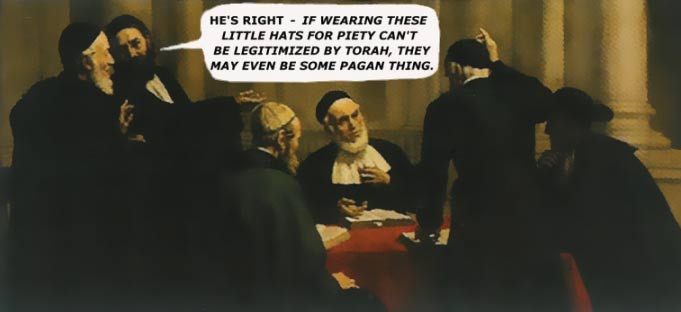
The DOME shape itself is derived from ancient Pagan symbolism, and was absorbed into the architecture of Christianity and Islam directly from Pagan temple architecture. The "eye" of the Sun (the principal Pagan deity) was able to "see" into his temple through an "oculus" at the upper-most section of the dome, which was simply an enormous hole in the top (see Pantheon, Rome). In some Christian "churches" (they often refer to a "church" as a building), the domed architecture will even include an enormous EYE centered in the center of the dome, looking down at the congregation.
Creepy. One of the most famous DOMED structures in the world was the Roman temple called the Pantheon, dedicated to many Roman deities. The dome was a secret allusion to the "dome of the sky", which the Pagans worshipped profusely. The word "domus" is Latin for "house", the dwelling or temple of Pagan deities in this case - but it also gives us words like "domestic". Dome is also slang for "head". "Dominus" means "lord". The domed building called "St. Peter's Cathedral" is directly modeled after the former Roman temples, and many government buildings around the world designed and built by Masons sport the Pagan architecture proudly. If you really dig, you'll find the shape is entirely rooted in the old Pagan theme, sex -- just as the steeples and obelisks are. The ancient root, dem, means to "join together", as it relates to sex. Look at the word "con-dom", and you see it. The word dominam was used for the male member. But keep reading . . .
2.THE WEARING OF "SPECIAL" GARMENTS
The wearing of "special" garments came directly from the Roman magisterial system, along with the philosophical idea that "the clothes make the man". Hierarchical positions of authority were mimicked from the Roman system of government. The nicolaitan approach to the functions within Yahushua's Body quickly became the norm, and Yahushua's authority was usurped by men, ranking their positions over one another.
The early "church fathers" were former Pagans, and were also teachers who regularly spoke before large audiences. The term for their important position was "sophist" (from the Greek word, wisdom), and they were essentially professional speakers. The "3-point-speech" technique was refined by these hired speakers, who were among the most highly-honored people of their day. The practice of eating a dinner and listening to a renowned speaker comes to us from the Greek culture. They wore a distinctive costume, similar to the robes of a court judge today. They would also drape their robes with any ribbons or awards they may have received in the past, to punctuate their importance. Have another quick look at the "wise guy" at the top of this page!
Whenever we want to know about something that we may be a little confused about, all we have to do is picture Yahushua, and ask ourselves what His opinion might be.
Knowing how humble He is, it's doubtful He would wear a special garment to make us notice Him. When He was engaged in washing the feet of His students, they were debating who among them was the greatest -- they were already trying to decide their "rank". The home assembly for Scripture study is the best arrangement, however you might want to leave the "special" garment idea out. The urge to wear such things is not coming from our humble Mashiach, but rather the world.
So, why would anyone want to feel special wearing a garment and/or a little domed hat, a dome on their dome? Obviously to make a statement. Hats were often used to designate a person's status. They added the propellers much later on (beanie-copters), and "dunce hats" were very popular with the school kids of long ago. Roman priests used hats to announce their office in the Church. Santa Claus wears a "Phrygian hat", exactly like the Roman deity "Mithras". Pagan priests also shaved their heads in various ways; one way was called a "tonsure", where the entire crown of the head above the ears was shorn, displaying the mark of their slavery to the SUN. The caps may have provided some protection from the sun's burning rays on the sensitive exposed scalps. But, that's only a guess, since the origin of the tonsure itself is buried in antiquity - but it is suspected to have been linked in some way to sun worship. Some people will believe anything you tell them, and will imitate what others do without question. I've heard that if you wrap your head up in a towel that is colored purple, the aliens (from outer space) will not be able to read your mind. No doubt, there's someone living near Roswell, New Mexico, that believes this. UFO museums would have no customers at all if people weren't so easily misguided.

Dome of the Rock, Temple Mount, Yerushaliyim, Yisrael
We keep on shoving domes into the face of YHWH, don't we?
Actors, and DOMES, are EVERYWHERE in your face: THE CATHOLIC SHAMAN AND COMPANY:
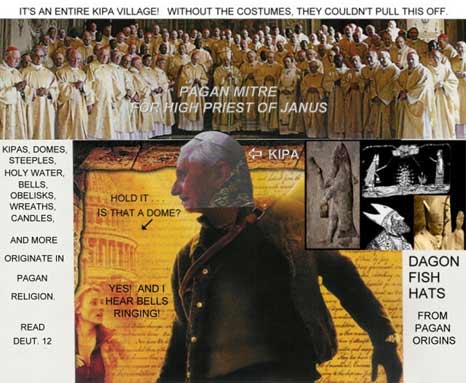
While we're discussing things people invented to do, what about this . . .

This is a photo of Bush's right hand on the Western Wall, his head domed. He and everyone else is facing EAST, talking to their Creator, right? Many BOW to this wall, and rock their bodies in its direction . . .
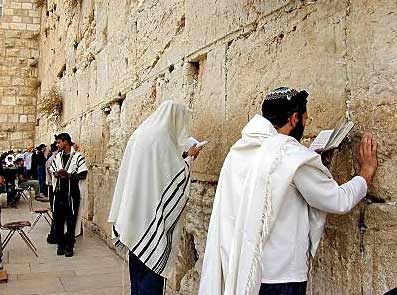
Many people have read the Scriptures, and it's a sure thing that this behavior isn't described in them. But, there are examples of people starting up their own "strange" patterns, like the worshipping of the golden calf, and the serpent on the pole. YHWH had them grind these two objects to powder, and drink them. Are you thinking what I'm thinking? Research on the "tradition" of Jewish men wearing a hat, we find that Catholic communities in Medieval times found it difficult to identify who was Jewish and who was not. All were bare-headed. So, the Catholics required the Jewish men to wear special hats so they could be easily distinguished from Catholics. The Catholics themselves gradually embraced the habit, so today the "clergy" wears the same headwear as you can see in the photo below.
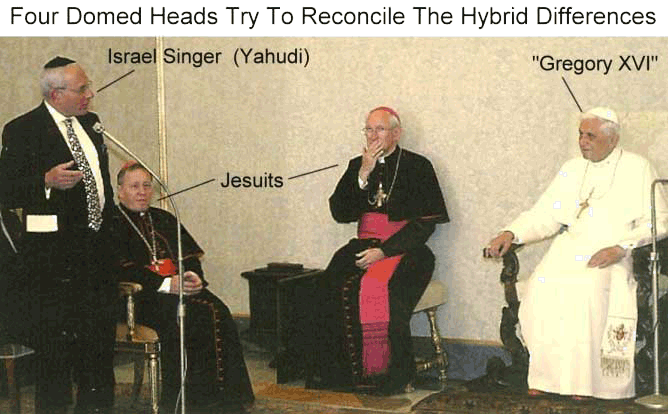
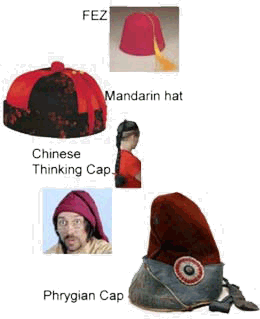
Another odd fact: They won't even let you enter the area of the Western Wall without putting a dome (kipa) on your head. Now, picture this in your mind: let's say you're the Creator, looking at the Temple Mount area. You see hundreds of your people (Israel) facing the Western Wall bobbing toward it. Each one has a little dome on their head, and they are bobbing in the direction of a huge GOLD DOME on the level above them. In effect, little domes are bobbing toward the biggest dome of all. Ethnology experts have observed that the old cultures that practice witchcraft place great emphasis on the headwear of their shamans, who also often wear aprons.

New pope/Shaman wearing Santa cap
Another "tradition" we all relate to is found in the old adage, "If I'm wrong, I'll eat my hat". O.K., so if you lean toward wearing a hat to honor YHWH, although He never told us to in Torah, you may have discovered one of those "works" that will be tested in the "fire" (Torah). If you are wearing your hat, and I'm not, but we're both standing before YHWH to answer for our practice on this, I won't have to eat my hat for being wrong. I tend to respect the practice of removing one's shoes and bowing in prayer to YHWH. When Daniel was bowing and praying toward Yerushalayim when he was in Babylon, the men who were closely watching him to see if he would disobey the new anti-prayer law of the king might have seen him remove his shoes and bow down to the floor of his chambers. The Hebrew word for worship: SHACHAH (#7812), which literally means to bow down, or prostrate before another who is of higher status. If we really want to perform an outward act that we know will receive YHWH's eternal approval, which would you say would be better: wearing a special hat because someone dreamed-up the idea, or bowing down to Him?
More religious costume commentary:
DID YOU KNOW? The truth about the history of women covering themselves with robes and full head disguise is quite different than what most have come to accept. When an ancient man saw a woman covered up, as with a BURKHA (which means veil), it was a signal to him that she was a prostitute. By deduction, women who were uncovered would not be prostitutes. Tamar heard that Yahudah was leaving to go shear sheep, and disguised herself by covering up as the prostitutes did:
"And it was told Tamar, saying, 'Behold your father-in-law is going up to Timnath to shear his sheep.
And she put her widow's garments off from her, and covered herself with a veil (or shroud), and wrapped herself, and sat in an open place, which is by the way to Timnath; for she saw that Shelah was grown, and she was not given to him as wife.
When Yahudah saw her, he thought her to be a harlot; because she had covered her face.
And he turned to her by the way, and said, 'Come, now, let me come into you' (for he knew not that she was his daughter-in-law.) And she said, 'What will you give me, that you may come into me?'" Gen./ Bereshith 38:13-16
There is perhaps nothing that symbolizes the oppression of women better than a burkha (burqa, burka).
As we ponder the full head disguise for women in public, we have to wonder about the "wedding veil" - is it's real meaning the ancient signal that the woman is ready to give herself to the man, as we clearly understand it's meaning was in the Scripture above? Possibly so.
CONFUSION: Michael Jackson shouldn't be on this page twice, but see if you can find him in the photos below:
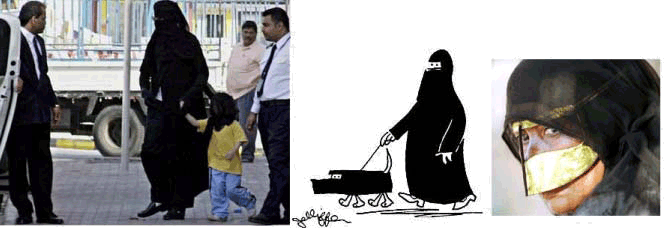
To ancient society, is Michael Jackson dressed as a harlot?
It's not allowed by the Torah of Yahuah to dress as a woman if you're a man - and a woman is not to dress as a man. It's confusing.
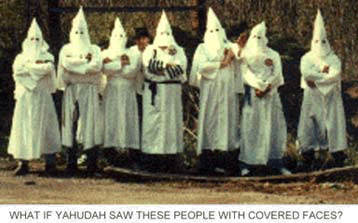
The Ku Klux Klan began after the Civil War as Albert Pike's means of re-igniting the conflict between the north and the south - it was a Masonic conspiracy, but you can search that out yourself. These men are racists and consider their mission to be "religious", so their costumes are "clerical garb" in their minds. The Inquisition wore identical costumes as they tortured their victims. To ancient society, some of our customs might be shameful. What's culturally acceptable changes. Wearing pajamas, towels, dunce hats, or whatever is not against a specific Torah instruction, but if people start telling us that it is required for "religious" reasons to wear costumes or hats, then that is getting out-of-bounds. Yahuah's Torah prohibits the adding or taking away of any of His instructions.
LET'S PLAY PEEK-A-BOO, SHALL WE?
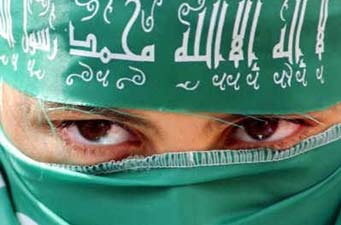
Who's hiding underneath, a woman or perhaps a man ?...
Is this really the way our Creator wants us all to dress? If so, we are very, very sick creatures. Imagine visiting another planet with intelligent life. Suppose you found the males dressed like the Masonic Inquisitors above, and all the females dressed like this woman.
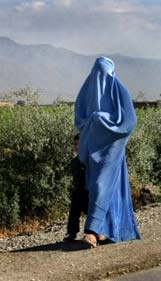
If you asked them why they do this, they might say the Creator wants them that way. So, you ask them to produce the proof of this, and they bring out a huge scroll, but fail to actually find anything about it in that scroll. Not finding anything specific, one of the older ones sighs and says, "Well, it's just nature that demands this.
We also carefully monitor the hair length of the males, and the women have to grow their fingernails - this is to scratch any males who try to attack them. See? Nature itself demands these things." Uh-huh . . . that's messed up; it's no wonder the psychiatrists are so busy here.

